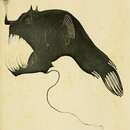en
names in breadcrumbs


View data on Catalog of Fishes here.
Frontal spines absent; spines of sphenotic, preopercle, angular, and symphysis of lower jaw sharply pointed; teeth on each premaxillary 9–14, arranged in four series; teeth on each dentary 7–9, in three series, longest tooth 13–18% SL; a single pair of vomerine teeth in two smaller specimens, two pairs in largest known specimen; dorsal-fin rays 3; anal-fin rays 3; pectoral-fin rays 16 or 17.
Length of illicium 26–39% SL; escal appendages similar in basic pattern, but differing in shape in three known specimens: anterior escal appendage (1) a simple compressed flange, with smooth edge in 28.6-mm holotype, (2) compressed with deeply notched serrated edge in 51-mm specimen, and (3) distally prolonged into a pair of fringed flaps in 34-mm specimen; distal escal appendage (1) pigmented except on tip, simple cylindrical with a simple distal filament in 28.6-mm holotype, (2) with scattered melanophores, a short pointed posterolateral branch, and a distal filament with tiny lateral branches in 51-mm specimen, and (3) pigmented at base with several fringed flaps on anterior margin and distal tip; largest specimen differing further from two smaller specimens in having a filament on tip of pair of structures at posterior base of distal appendage, and a short filament on each side of dorsal part of escal bulb.
Hyoid barbels of three known specimens also highly variable: total length of barbel 118–160% SL in two smaller females, 360% SL in 51-mm specimen; barbel of holotype bearing a number of short lateral branches irregularly spaced along length of stem, somewhat longer and more close-set distally, but without forming a distinct tassel; barbel of two smaller specimens with a distal tassel very similar to those of L. coronata; tassel of 34-mm specimen consisting of three proximal branches, a medial pair of branches, and three primary distal branches, each branch subdivided and bearing stalked and sessile photophores; tassel of 51-mm specimen consisting of a tapering proximal pair of primary branches, with a number of small photophores on slender stalks, and a distal cluster of 30–40 stalked photophores of varying size on a short stout base; stem of barbel of 34-mm specimen simple, without lateral branches, that of 51-mm specimen with short lateral branches throughout its length, each with a photophore on distal tip.
Subdermal pigmentation of holotype somewhat bleached; remaining specimens with slight but distinct concentration of subdermal pigment on caudal peduncle.
Metamorphosed females of Linophryne arcturi differ from those of all other species of the genus in having the following escal and hyoid barbel characters: escal bulb with a compressed flange-shaped anterior appendage; a stout cylindrical distal escal appendage with terminal filament; base of distal escal appendage with a pair of structures on posterior margin, each consisting of a hemispherical protuberance with an digitiform anterior prolongation; a compressed posterior escal appendage. Barbel 118–357% SL, with several short, unpigmented distal branches bearing sessile and stalked photophores; stem of barbel pigmented with or without short simple lateral branches, each with a distal photophore.
The holotype of L. arcturi was caught in the Eastern Tropical Pacific off Cocos Island, Costa Rica, the other two specimens in the Eastern Atlantic: the ISH specimen from off Ascension Island and the BMNH specimen from south of Madeira.
Meso- to bathypelagic. All were caught in open nets with maximum fishing depths between 650 and 1900 m.
Pietsch TW. 2009. Oceanic Anglerfishes: Extraordinary Diversity in the Deep Sea. Berkley: University of California Press. 638 p.
Parasitized females have a single attached male, in contrast to the linophrynid genera Haplophryne and Borophryne (and the ceratiid genera Ceratias and Cryptopsaras) in which females with two or more males are known. In all known cases parasitized females of the family, the male is directed forward with respect to the female and attached in nearly the same position on the ventral midline of the female, somewhat in front of and below the sinistral anus; with only one or two exceptions, all are attached upside down with respect to the female. This is again in contrast to the linophrynid genera Haplophryne and Photocorynus (and the ceratiid genus Cryptopsaras) in which males may attach in any direction and almost anywhere on the head and body of the female. In all known examples, the males are attached by both upper and lower jaws, leaving prominent openings on each side that lead into their mouths and opercular cavities; there is no papilla of tissue projecting from the female into the mouth of the male.
Known from three metamorphosed females (28.6–51 mm).
ARCTURUS station 74 T-70, south of Cocos Island, Costa Rica, 4°50'N, 87°00'W, open pelagic net, 915 m (500 fathoms), 2 June 1925.
Holotype of Diabolidium arcturi: CAS-SU 46505 (formerly NYZS 6333), 28.6 mm.